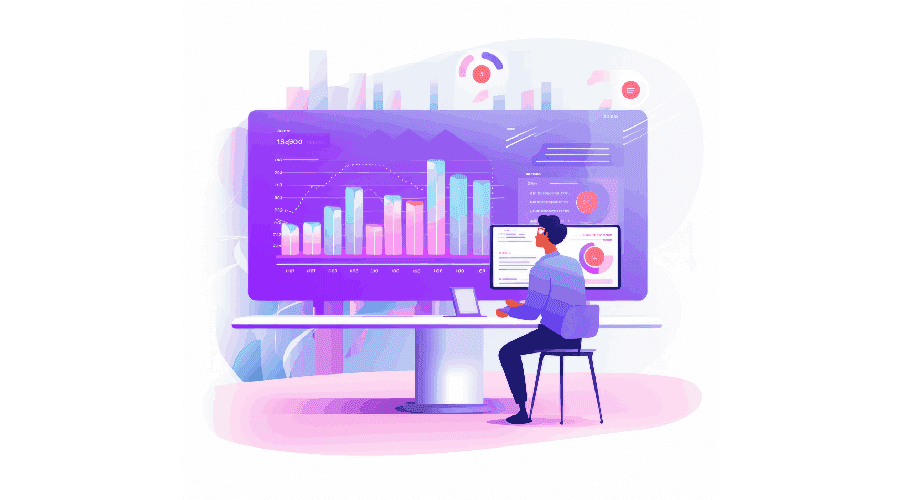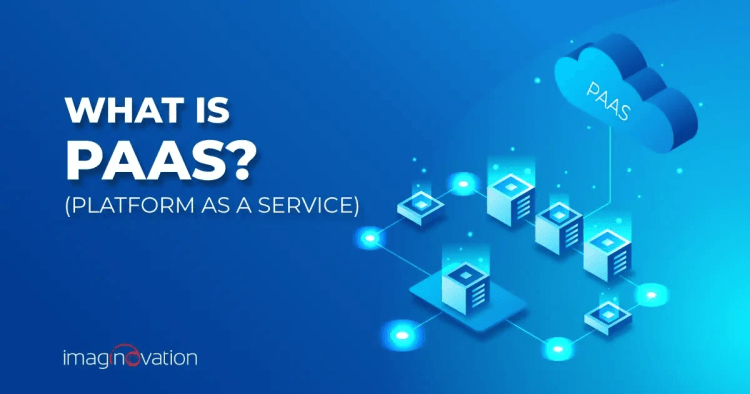Are you considering creating your app and feeling overwhelmed by the challenges of acquiring server space? Are you worried about the complexities, time, and costs of maintaining an on-premise app development environment?
If these concerns sound familiar, it may be time to explore a smarter solution: Platform as a Service (PaaS).
Read on to discover how PaaS can transform your software development workflow and save you valuable resources.
Learn more about the PaaS benefits, different types of PaaS solutions, and how to choose the right PaaS provider.
Understanding Platform as a Service (PaaS)
Platform as a Service, or PaaS, is a cloud computing model that allows developers to build and manage apps without worrying about the underlying infrastructure.
Whether you are a developer or a business user, PaaS lets you focus on creating great apps with clicks and code without worrying about hardware and software infrastructure.
With PaaS, your apps can be developed and hosted quickly and at very nominal setup costs without any risk of delays or inefficiencies caused by infrastructure issues.
In the family of cloud computing services, PaaS is the "middle layer," sitting between Infrastructure as a Service (IaaS) and Software as a Service (SaaS).
Key components of PaaS
Core components of PaaS include development tools, programming languages, databases, runtime environments, application servers, and other resources that are easily accessible through the cloud without the expense and complexities of building them in-house.
PaaS vs. IaaS vs. SaaS
Unlike IaaS, which focuses on providing virtual computing resources like storage and networking, PaaS offers a complete platform for app development. Cloud providers like Amazon Web Services, Stackscale, and Microsoft Azure offer IaaS services.
On the other hand, SaaS delivers software applications over the Internet. It eliminates the need for end users to install and maintain the software on their devices. The cloud provider handles everything: infrastructure, app, and platform. Examples include Google Workspace and Microsoft Office 365 solutions that only need an internet connection and a device to operate.
PaaS stands out by offering the tools and environment needed for developers to create custom applications and services. This makes it a preferred choice for companies looking to build and deploy scalable, high-performance applications efficiently. Examples include Cloud Foundry.
According to the statistics:
- The global PaaS market reached 56.2 billion USD in 2020 and is expected to grow at a CAGR of 19.6% from 2021 to 2028.
- The most prominent players in the global PaaS market are Microsoft Azure, Amazon Web Services, IBM Cloud, and Google Cloud Platform. Microsoft and Amazon dominate over 80% of the global IaaS and PaaS market. Other significant players include Alibaba, Salesforce, Oracle, and Rackspace.
- About 32% of businesses use PaaS to develop and test software applications.
Types of PaaS Solutions
Are you looking for a platform to build, integrate, and manage your applications without worrying about the infrastructure? Platform-as-a-Service (PaaS) can provide you with this and more.
However, not all PaaS solutions are the same. Selecting the right type for your company’s requirements is crucial, as it can save you time, money, and effort.
Here's a list of various PaaS solutions you can choose from.
1. Application Development PaaS
Application Development PaaS is the right choice if you're looking to build and deploy new applications. This user-friendly PaaS offers software development kits (SDKs), programming languages, and database management systems for a streamlined development process. It also provides computing power, memory allocation, and storage resources, allowing developers to build applications more efficiently. It is ideal for businesses operating without any dedicated IT department.
2. Integration PaaS
Integration Platform as a Service (iPaaS) is a suite of automated tools that enable the integration of software applications across various environments. It is fundamentally valuable for resolving businesses' application and data integration challenges. iPaaS is ideal for enterprises that need to integrate on-premises and cloud applications and data. It offers pre-built connectors, business rules, maps, and transformations to expedite application development and orchestrate integration flows.
3. Data PaaS
Data Platform as a Service (Data PaaS) is a cloud-based service that provides organizations with the tools and infrastructure to manage and analyze large volumes of data. With Data PaaS, businesses can leverage scalable infrastructure and advanced data processing technologies to handle growing data volumes and extract meaningful information. It enables organizations to easily integrate data from various sources into a centralized data repository.
4. API Management PaaS
API Management PaaS is ideal if you need to manage, secure, and monitor your APIs efficiently. This cloud-based service helps design, publish, and analyze APIs for smooth integration between software applications. Features like access control, rate limiting, and throttling ensure secure and reliable API access, making PaaS perfect for enhancing API management in the cloud.
5. Business Analytics PaaS
Business Analytics Platform as a Service (BaPaaS) is a cloud-based service. It helps you analyze and extract insights from your data. This aids in driving informed decision-making. It also improves business performance by offering a comprehensive platform. This includes data visualization, predictive analytics, and reporting.
For example, a retail company can utilize BaPaaS to analyze customer purchasing patterns and preferences to optimize inventory management and marketing strategies.
Benefits of Using PaaS
With Platform as a Service (PaaS), you can say goodbye to the hassle of evaluating, buying, and configuring hardware and software. Embrace the simplicity and convenience PaaS brings to the table. Get ready to enjoy a host of technical and business benefits:

1. Reduced development time
With PaaS, you can build apps faster. It provides instant access to a comprehensive software development environment, tools, templates, code libraries, and pre-programmed application components, reducing coding time. Since you no longer need to manage the hardware and software, this frees up your time for application development. Plus, when you sign up for PaaS, you can start using the system immediately, with no setup time lag.
2. Cost efficiency
Using PaaS platforms saves upfront costs since you don't need to build anything before developing apps. You don't have to reinvent the wheel each time you make a new app, cutting down on development costs. Capital costs that are tied to expensive IT assets are replaced with operational expenses. With PaaS's pay-as-you-go model, you can access advanced development programs and analytics solutions that might have been financially out of reach.
3. Scalability
Scaling an on-premises platform is costly and inefficient. It requires extra computing, storage, and networking power that often remains unused during traffic lulls. With PaaS, your application can immediately scale up during peak times and down when demand is low. You can adjust resources based on current needs and pay accordingly.
4. Flexibility
Another benefit of PaaS is its flexibility, allowing businesses to adapt to changing needs. PaaS handles hardware and software updates, maintenance, and scaling tasks, unlike traditional on-premises platforms. This lets organizations focus on core objectives without worrying about infrastructure. Additionally, since PaaS is a cloud-based solution, it can be accessed from anywhere, thus facilitating remote work.
5. Enhanced Collaboration
PaaS enhances collaboration, leading to better teamwork and productivity. Team members can access and work on the same platform simultaneously, ensuring seamless collaboration and communication. It also enables real-time editing and version control, keeping everyone up-to-date. This is especially beneficial for remote teams working across different time zones.
6. Efficient App Lifecycle Management
PaaS combines all necessary tools and services for easy development, deployment, and maintenance, simplifying the process and helping developers track the app lifecycle. With PaaS, managing the app lifecycle from creation to retirement becomes less complex. Developers can build, test, and update apps quickly without managing infrastructure, resulting in faster time to market.
7. Integrated Security
An often-overlooked benefit of PaaS is its robust security measures. The platform offers features offering built-in protections for the physical infrastructure and operating system, allowing consumers to focus on other tasks without worrying about security.
However, companies are still responsible for ensuring the service's usability, addressing security issues, accessibility, data deployment, and product quality.
8. Automatic Updates and Maintenance
An application on an on-premise server requires constant updates, patching, and security maintenance, requires a specialized team, and makes frequent upgrades difficult. PaaS removes these limitations by providing regular updates and ensuring the security of your infrastructure. PaaS providers automatically update necessary components, saving you from implementing new features and eliminating the need to hire additional staff.
Common Use Cases of PaaS
Knowing how PaaS can be applied in business operations can help maximize its potential. Companies can optimize their processes, increase productivity, and improve business efficiency by applying appropriate use cases.
Here are some of the popular use cases of PaaS:
1. Application Development and Deployment
Heroku is an excellent example of a cloud Platform as a Service (PaaS) that has revolutionized app creation, deployment, and management. It simplifies infrastructure management, allowing developers to focus on coding and delivering features, boosting productivity.
Supporting various programming languages like Ruby, Java, PHP, and Python and offering a user-friendly interface and simplified deployment, Heroku is a go-to choice for startups and individual developers.
2. API Management and Integration
Discover seamless API management with the MuleSoft Anypoint Platform. It’s an all-in-one PaaS solution that simplifies the entire API lifecycle. From API creation to retirement, experience the ease and efficiency of a unified PaaS product.
MuleSoft Anypoint allows effortless deployment of API gateways in diverse environments, ensuring smooth integration. With flexible policy options, you can control your APIs. Users can share and discover APIs and connectors, fostering collaboration and accelerating innovation.
3. Data Management and Analytics

Google’s enterprise data warehouse, BigQuery, makes large-scale data analysis accessible to all. Traditional systems lead to longer wait times, but BigQuery handles massive data swiftly, whether it's log data from retail systems or IoT data from vehicle sensors worldwide. This fully managed, serverless data warehouse frees you from infrastructure management, allowing you to focus on analytics.
BigQuery eliminates data silos, promotes collaboration, and ensures data security with Google Cloud's identity and access management. You can assign specific permissions to users, groups, or projects, keeping sensitive data secure while enabling seamless collaboration.
4. Mobile Backend as a Service (MBaaS)
Amazon provides a well-known Mobile Backend as a Service (MBaaS) called AWS Amplify. It offers tools and services for mobile app development, including authentication, storage, analytics, and machine learning.
AWS Amplify is a comprehensive suite of libraries, UI components, and a command-line interface (CLI) used by organizations like HyperTrack, Orangetheory, and Branch. Key features include built-in user management, push notifications for mobile and web clients, multiple data storage options, and support for AI/ML capabilities like image recognition and speech transcription.
5. IoT Application Development
Azure IoT is a platform offering multiple Microsoft-managed cloud services that enable organizations to connect, monitor, and control diverse IoT assets. It provides hosting for various IoT solutions and facilitates the connection, storage, and analysis of data from field devices.
Azure IoT supports connections to data loggers and other edge equipment from various manufacturers. It is a flexible solution for organizations aiming to transfer their IoT process data to the cloud.
How to Choose the Right PaaS Provider
PaaS is great for developers seeking cost-effective control over the simplified application hosting and deployment. However, not all PaaS solutions have the same feature set, and solutions offered by different providers may differ.
Here’s how you can select the right PaaS provider.
1. Evaluating Business Needs & Objectives
When choosing the right PaaS provider, evaluate your business needs and objectives. Analyze your existing IT infrastructure and processes to spot bottlenecks and areas for improvement. Check what your business needs — agility, innovation, or efficiency. Next, clearly define your goals with PaaS. Do you aim to boost application development speed, lower costs, or improve collaboration?
2. Consider Integration Capabilities
Integration capabilities are critical when choosing a PaaS provider. Assess how flexible the platform integrates with your existing systems, databases, or APIs. Check the availability of integration tools, pre-built connectors, and features like data transformation. Additionally, ensure the platform can handle scalability and performance optimization during integration tasks.
3. Assess Scalability and Flexibility
Evaluate how the PaaS provider's platform adapts to changing demands and manages increased data volume. This is essential for resource scaling and cost optimization. Research the provider’s case studies to understand how they handle high user loads. Deploy a sample application for performance testing. Check the platform’s auto-scaling capabilities and resource allocation flexibility.
4. Review Security and Compliance Standards
Select a provider that meets your security requirements and standards. Seek answers to the following questions - What is the provider's reputation regarding data protection and encryption? Do they have relevant certifications? What are their policies and practices for backup, recovery, and compliance? Additionally, review the service level agreement (SLA) and clarify their roles and responsibilities in the event of a security breach.
5. Analyze Cost and Pricing Models
When analyzing a PaaS provider's cost and pricing models, consider how they calculate costs. Do they offer pay-as-you-go or subscription options? Are there hidden costs or discounts for long-term commitments? Also, factor in the impact of resource usage on cost and clarify what's included in pricing packages. Do they charge extra for support or maintenance? Every single piece of this information will help you make an informed decision to meet your budget and business goals.
6. Check Provider Support and Community
This is another essential factor in selecting the right PaaS provider. Check the provider’s support options and response times to issues. Assess the strength of their community, including forums, user groups, and available resources. Assessing these factors ensures you have reliable assistance and a supportive community when using the platform. Good support helps you troubleshoot issues and avoid costly disruptions to your operations.
Transform Your Business with PaaS Solutions
PaaS empowers small and new businesses to plan for growth without the hassle of platform maintenance, allowing them to focus more on core business activities.
As technology evolves, leading cloud providers offer advanced technologies with PaaS, like AIaaS, opening up AI capabilities to businesses.
With cloud computing becoming the new norm, it is time you invest in this technology and transform your business.
Do you see cloud computing, specifically PaaS, shaping the future of your business operations, application development, and deployment? Are you considering using PaaS to streamline your business growth plans?
If so, please get in touch with us at Imaginovation. Let's talk.
Ready to build an app, but not sure where to start?
We've got you covered. Click the button below to get started.





